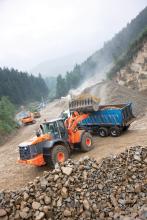Infrastructure projects are probably the most important drivers in Sweden’s aggregates industry. Julie-Anne Ryan reports
Few national aggregates industries have records that go back as far as those of Sweden, which can track its production figures back to 1930: about 12-13 million tonnes back then, incidentally.
So it’s ironic that the latest official figures currently available refer only to 2009, an issue that causes great frustration among the powers that be at the Swedish Aggregates Producers Association (SBMI).
Experts are well placed though to make estimates for 2010/2011, basing their information on the drop in production from its peak in 2008, a global effect of the recession at the time, and other specific issues.
“Small companies phase out and bigger companies grow,” said SBMI managing director Björn Strokirk. “We are phasing out sand and gravel pits and opening bigger rock quarries that are more demanding to operate, and more importantly, it is more and more complicated to get permissions for operation.
“The total volume will not change very much in the foreseeable future.”
The modern peak in 2008, a total of 101 million tonnes, while substantial, was still some way down on the decades after the Second World War, when the construction of a million apartments for young people resulted in an exceptionally high consumption of sand and gravel. From less than 30 million tonnes in 1945, production soared to 130 million tonnes and more by 1970. These figures had settled by the 1980s and 1990s.
So from 2008’s 101 million tonnes, total deliveries of aggregates in Sweden fell by 16% in 2009 to a total of 84.5 million tonnes worth about €1 billion. This was the lowest figure since 2005.
According to the report published by the
The report continued: “Aggregates from industrial mineral pits, dimensional stone pits and metal ore mines totalled 0.8 million tonnes, mostly in the form of crushed bedrock. There were 2,310 licensed pits and quarries in Sweden in 2009, of which 1,994 were primarily intended for aggregate production. The remaining 316 were licensed for the production of dimensional stone, industrial minerals, soil and peat. There were 3,565 licensed pits in 1999, delivering an average of 22.123 million tonnes, compared with the situation in 2009, when there were 2,268 production sites (mobile crushers included), with average registered deliveries of 37.254 million tonnes.”
A significant change over the years has been in the proportion of aggregates used for road construction. While this increased to 56% in 2009, from 51% in 2008, the proportion of natural sand used in road construction has fallen, from 43% in 1998 to just 19% in 2009.
Jan Bida, technical manager at SBMI, explained: “Sweden is comparable to somewhere like Scotland: a lot of rock, not everywhere but very good occurrence of hard rock, which means that when we make a new motorway we normally balance the material in the road line, in other words soil, earth, blast rock from the hills, and use it to fill valleys.
Normally, most of the sub-base material (0/90mm or 0/125mm) is coming from the road line and also from the road base or base course (0/32mm or 0/45mm). Those quantities are only partly included in the statistics. I tried to make our own estimates, based on the use of explosives, and I think that we estimated this volume that’s not included as between five and ten million tonnes, probably closer to ten, from road construction and railway construction sites, new harbours or extensions to existing harbours and also construction sites in general.
“And we estimate that the total production figure for 2010/11 will be 90 million tonnes.
“Also we have in the last ten years spent a lot of money on new tunnel projects. The rock we use is a mix of good quality and poor quality, so no good as aggregate for concrete: it’s used as a filling aggregate.
“Most aggregates for sub-base and base course are from the road line, not quarries. All the aggregate for bitumen mixes is coming from quarries and also concrete products, ready-mix and prefab.”
One of the key issues on which the industry has been working is the reduction of extraction and consumption of sand and gravel.
“The Swedish parliament sees sand and gravel deposits as being a very, very important reservoir for ground water,” said Bida. “Sand and gravel is a finite resource, unlike rock, which is not a finite resource because we have so much of it. We agree that we should go over more and more from sand and gravel production and glacial deposits and substitute them with crushed rock aggregates. We would like to save our water for the next generation.”
Of course this means higher cost of extraction and production, but it is partly balanced by sand and gravel extraction tax, which is about £1 (€1.26) per tonne: there is no tax on crushed rock aggregates.
The main use of sand and gravel is for concrete, not construction, so it’s not so easy to use crushed rock instead. More than two-thirds of the Swedish crushed rock aggregate is produced by the mobile crushing plants (primary jaw crusher and the secondary cone crusher with the screen). This is why Sweden can operate so many quarries and gravel pits, many of which are small and can be operated on a campaign basis, said Bida.
There are only about 20 larger quarries (those producing more than 300,000 tonnes per year) with stationary crushing plants producing asphalt and concrete aggregates. These quarries are normally near major cities.
Geologically, Sweden is part of the Scandinavian Precambrian Shield consisting mainly of hard crystalline rocks such as granites, gneisses, gabbro, and porphyry. Sand, gravel and till deposits of quaternary origin represent less than 20% of the aggregates.
Economically, product value ex-work could be estimated to be €600 million, and product value at the customer site (including transport) about €900 million. The number of employees is about 1,500 (about 6,000 including sub-contractors and truck drivers).
There are five major aggregates producers:
NCC and Skanska have about 15-20% of the aggregates market, the others have about 5-10%. So these five companies account for more than 50% of the market. The remaining tonnage is well distributed among about 80 SME producers.
“In terms of future growth public infrastructure projects (roads and railways) are probably the most important drivers, with limited sensitivity to the economical situation in Europe. Other aggregate products are more sensitive in relation to the economical situation. We believe that there will be no growth, or very moderate growth, in the future: Sweden is a mature economy,” said Bida.
“The industry will continue to concentrate: the transition to more crushed rock aggregate, and less sand and gravel means higher investment costs. It means that more and more SMEs will be acquired by major players with more financial resources.”








